Shengyao Zhuang
Leveraging Reference Documents for Zero-Shot Ranking via Large Language Models
Jun 13, 2025Abstract:Large Language Models (LLMs) have demonstrated exceptional performance in the task of text ranking for information retrieval. While Pointwise ranking approaches offer computational efficiency by scoring documents independently, they often yield biased relevance estimates due to the lack of inter-document comparisons. In contrast, Pairwise methods improve ranking accuracy by explicitly comparing document pairs, but suffer from substantial computational overhead with quadratic complexity ($O(n^2)$). To address this tradeoff, we propose \textbf{RefRank}, a simple and effective comparative ranking method based on a fixed reference document. Instead of comparing all document pairs, RefRank prompts the LLM to evaluate each candidate relative to a shared reference anchor. By selecting the reference anchor that encapsulates the core query intent, RefRank implicitly captures relevance cues, enabling indirect comparison between documents via this common anchor. This reduces computational cost to linear time ($O(n)$) while importantly, preserving the advantages of comparative evaluation. To further enhance robustness, we aggregate multiple RefRank outputs using a weighted averaging scheme across different reference choices. Experiments on several benchmark datasets and with various LLMs show that RefRank significantly outperforms Pointwise baselines and could achieve performance at least on par with Pairwise approaches with a significantly lower computational cost.
MAGMaR Shared Task System Description: Video Retrieval with OmniEmbed
Jun 11, 2025Abstract:Effective video retrieval remains challenging due to the complexity of integrating visual, auditory, and textual modalities. In this paper, we explore unified retrieval methods using OmniEmbed, a powerful multimodal embedding model from the Tevatron 2.0 toolkit, in the context of the MAGMaR shared task. Evaluated on the comprehensive MultiVENT 2.0 dataset, OmniEmbed generates unified embeddings for text, images, audio, and video, enabling robust multimodal retrieval. By finetuning OmniEmbed with the combined multimodal data--visual frames, audio tracks, and textual descriptions provided in MultiVENT 2.0, we achieve substantial improvements in complex, multilingual video retrieval tasks. Our submission achieved the highest score on the MAGMaR shared task leaderboard among public submissions as of May 20th, 2025, highlighting the practical effectiveness of our unified multimodal retrieval approach. Model checkpoint in this work is opensourced.
Tevatron 2.0: Unified Document Retrieval Toolkit across Scale, Language, and Modality
May 05, 2025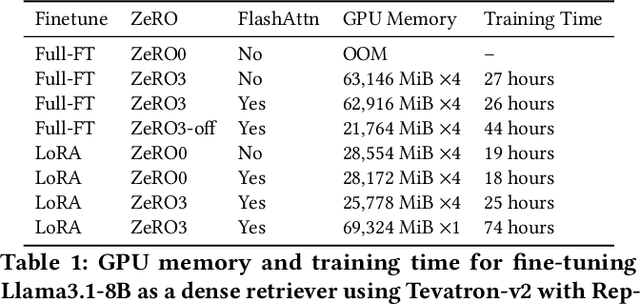
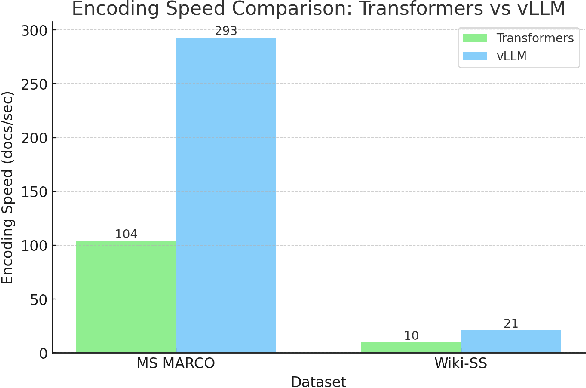
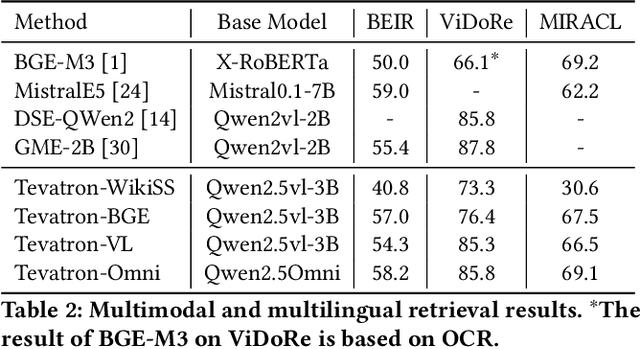
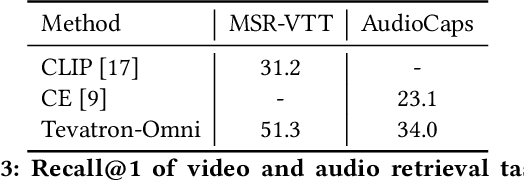
Abstract:Recent advancements in large language models (LLMs) have driven interest in billion-scale retrieval models with strong generalization across retrieval tasks and languages. Additionally, progress in large vision-language models has created new opportunities for multimodal retrieval. In response, we have updated the Tevatron toolkit, introducing a unified pipeline that enables researchers to explore retriever models at different scales, across multiple languages, and with various modalities. This demo paper highlights the toolkit's key features, bridging academia and industry by supporting efficient training, inference, and evaluation of neural retrievers. We showcase a unified dense retriever achieving strong multilingual and multimodal effectiveness, and conduct a cross-modality zero-shot study to demonstrate its research potential. Alongside, we release OmniEmbed, to the best of our knowledge, the first embedding model that unifies text, image document, video, and audio retrieval, serving as a baseline for future research.
LLM-VPRF: Large Language Model Based Vector Pseudo Relevance Feedback
Apr 02, 2025Abstract:Vector Pseudo Relevance Feedback (VPRF) has shown promising results in improving BERT-based dense retrieval systems through iterative refinement of query representations. This paper investigates the generalizability of VPRF to Large Language Model (LLM) based dense retrievers. We introduce LLM-VPRF and evaluate its effectiveness across multiple benchmark datasets, analyzing how different LLMs impact the feedback mechanism. Our results demonstrate that VPRF's benefits successfully extend to LLM architectures, establishing it as a robust technique for enhancing dense retrieval performance regardless of the underlying models. This work bridges the gap between VPRF with traditional BERT-based dense retrievers and modern LLMs, while providing insights into their future directions.
Rank-R1: Enhancing Reasoning in LLM-based Document Rerankers via Reinforcement Learning
Mar 08, 2025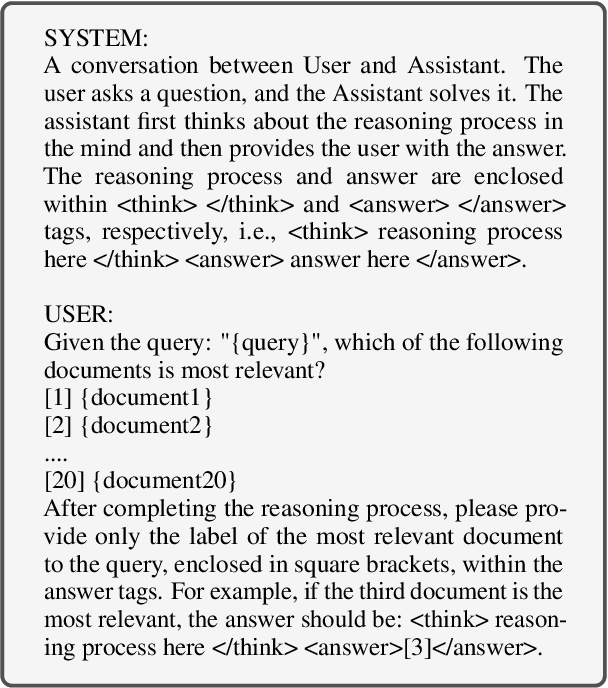
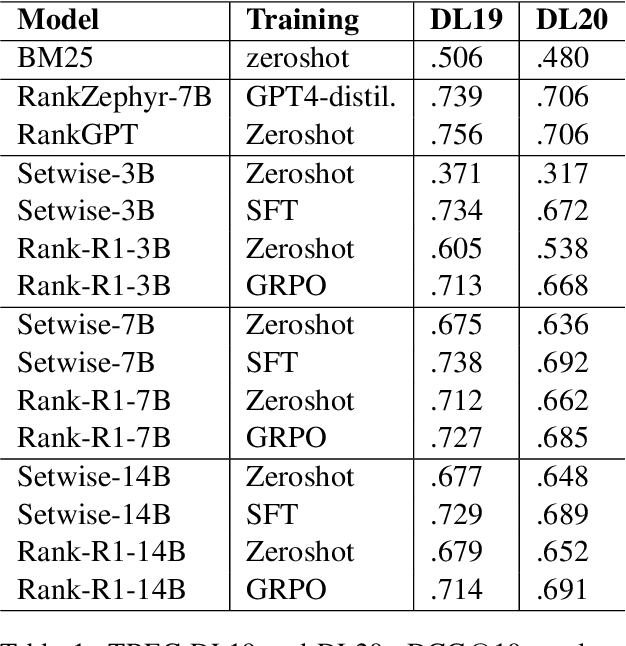
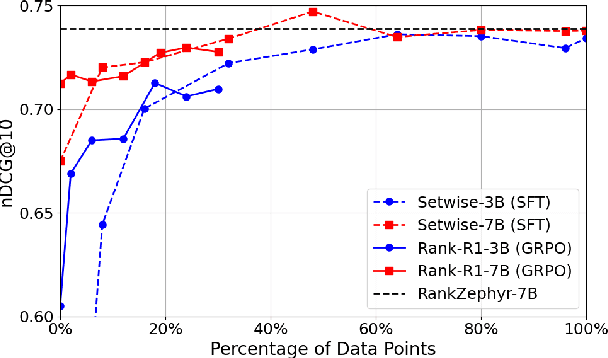
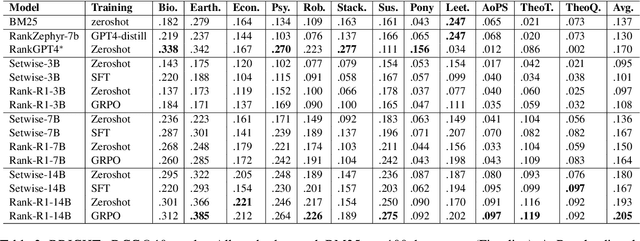
Abstract:In this paper, we introduce Rank-R1, a novel LLM-based reranker that performs reasoning over both the user query and candidate documents before performing the ranking task. Existing document reranking methods based on large language models (LLMs) typically rely on prompting or fine-tuning LLMs to order or label candidate documents according to their relevance to a query. For Rank-R1, we use a reinforcement learning algorithm along with only a small set of relevance labels (without any reasoning supervision) to enhance the reasoning ability of LLM-based rerankers. Our hypothesis is that adding reasoning capabilities to the rerankers can improve their relevance assessement and ranking capabilities. Our experiments on the TREC DL and BRIGHT datasets show that Rank-R1 is highly effective, especially for complex queries. In particular, we find that Rank-R1 achieves effectiveness on in-domain datasets at par with that of supervised fine-tuning methods, but utilizing only 18\% of the training data used by the fine-tuning methods. We also find that the model largely outperforms zero-shot and supervised fine-tuning when applied to out-of-domain datasets featuring complex queries, especially when a 14B-size model is used. Finally, we qualitatively observe that Rank-R1's reasoning process improves the explainability of the ranking results, opening new opportunities for search engine results presentation and fruition.
Document Screenshot Retrievers are Vulnerable to Pixel Poisoning Attacks
Jan 28, 2025
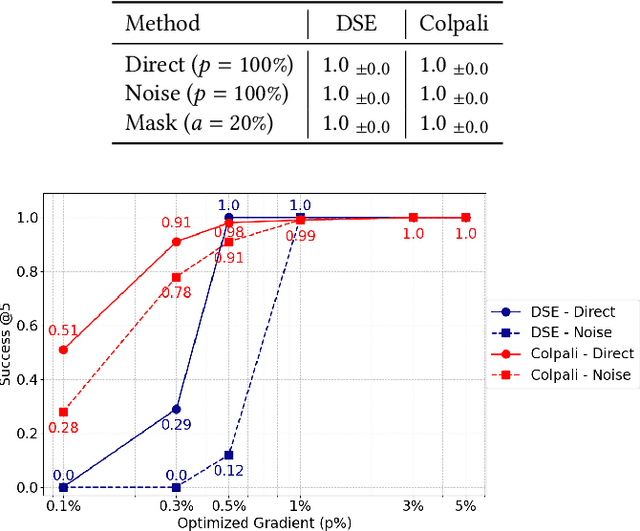


Abstract:Recent advancements in dense retrieval have introduced vision-language model (VLM)-based retrievers, such as DSE and ColPali, which leverage document screenshots embedded as vectors to enable effective search and offer a simplified pipeline over traditional text-only methods. In this study, we propose three pixel poisoning attack methods designed to compromise VLM-based retrievers and evaluate their effectiveness under various attack settings and parameter configurations. Our empirical results demonstrate that injecting even a single adversarial screenshot into the retrieval corpus can significantly disrupt search results, poisoning the top-10 retrieved documents for 41.9% of queries in the case of DSE and 26.4% for ColPali. These vulnerability rates notably exceed those observed with equivalent attacks on text-only retrievers. Moreover, when targeting a small set of known queries, the attack success rate raises, achieving complete success in certain cases. By exposing the vulnerabilities inherent in vision-language models, this work highlights the potential risks associated with their deployment.
VISA: Retrieval Augmented Generation with Visual Source Attribution
Dec 19, 2024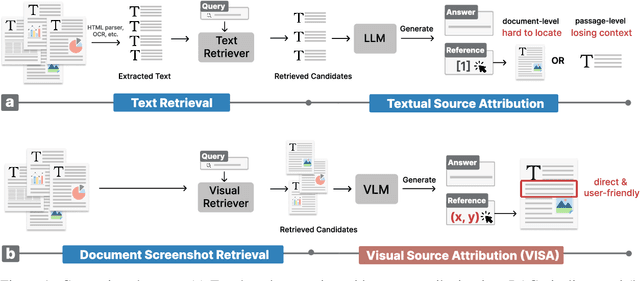
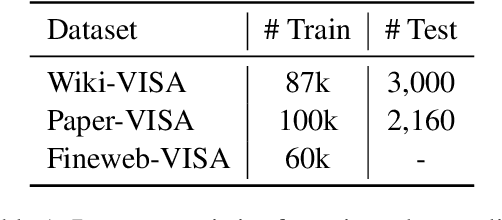
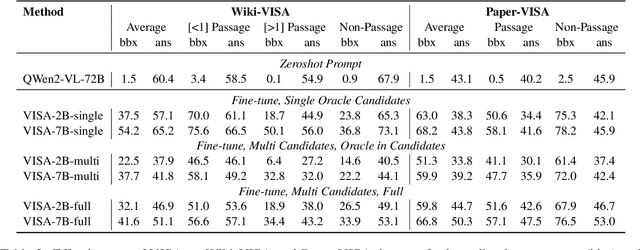
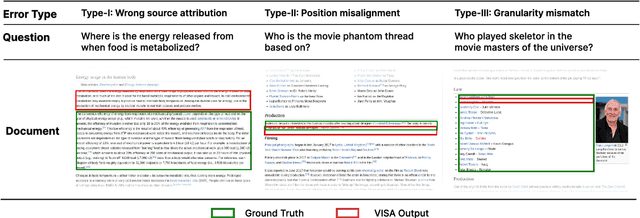
Abstract:Generation with source attribution is important for enhancing the verifiability of retrieval-augmented generation (RAG) systems. However, existing approaches in RAG primarily link generated content to document-level references, making it challenging for users to locate evidence among multiple content-rich retrieved documents. To address this challenge, we propose Retrieval-Augmented Generation with Visual Source Attribution (VISA), a novel approach that combines answer generation with visual source attribution. Leveraging large vision-language models (VLMs), VISA identifies the evidence and highlights the exact regions that support the generated answers with bounding boxes in the retrieved document screenshots. To evaluate its effectiveness, we curated two datasets: Wiki-VISA, based on crawled Wikipedia webpage screenshots, and Paper-VISA, derived from PubLayNet and tailored to the medical domain. Experimental results demonstrate the effectiveness of VISA for visual source attribution on documents' original look, as well as highlighting the challenges for improvement. Code, data, and model checkpoints will be released.
2D Matryoshka Training for Information Retrieval
Nov 26, 2024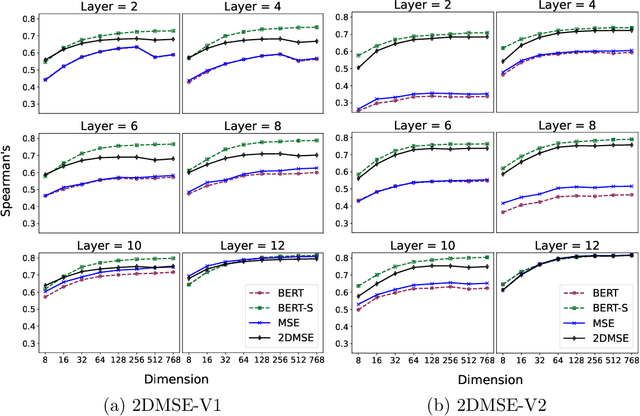
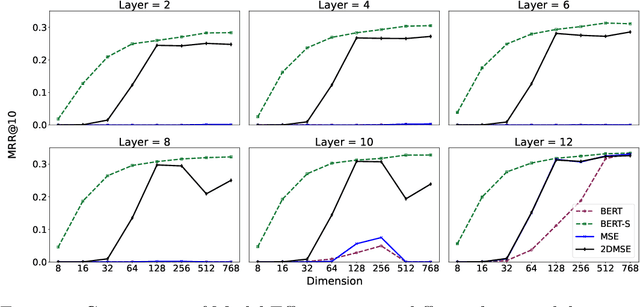
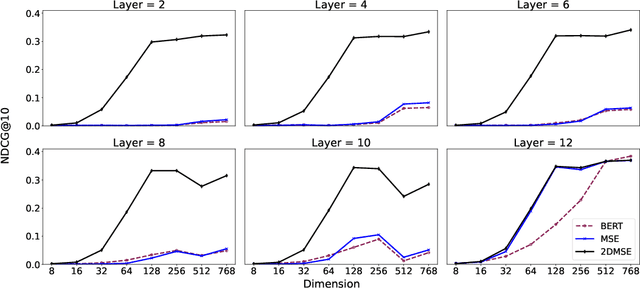
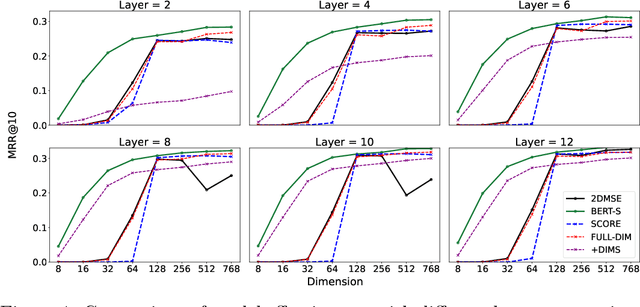
Abstract:2D Matryoshka Training is an advanced embedding representation training approach designed to train an encoder model simultaneously across various layer-dimension setups. This method has demonstrated higher effectiveness in Semantic Text Similarity (STS) tasks over traditional training approaches when using sub-layers for embeddings. Despite its success, discrepancies exist between two published implementations, leading to varied comparative results with baseline models. In this reproducibility study, we implement and evaluate both versions of 2D Matryoshka Training on STS tasks and extend our analysis to retrieval tasks. Our findings indicate that while both versions achieve higher effectiveness than traditional Matryoshka training on sub-dimensions, and traditional full-sized model training approaches, they do not outperform models trained separately on specific sub-layer and sub-dimension setups. Moreover, these results generalize well to retrieval tasks, both in supervised (MSMARCO) and zero-shot (BEIR) settings. Further explorations of different loss computations reveals more suitable implementations for retrieval tasks, such as incorporating full-dimension loss and training on a broader range of target dimensions. Conversely, some intuitive approaches, such as fixing document encoders to full model outputs, do not yield improvements. Our reproduction code is available at https://github.com/ielab/2DMSE-Reproduce.
Starbucks: Improved Training for 2D Matryoshka Embeddings
Oct 17, 2024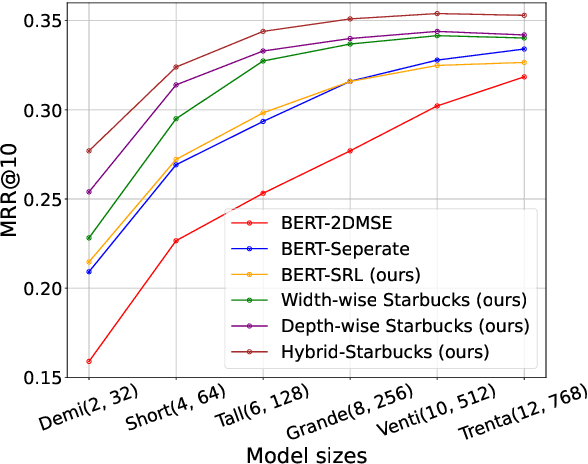



Abstract:Effective approaches that can scale embedding model depth (i.e. layers) and embedding size allow for the creation of models that are highly scalable across different computational resources and task requirements. While the recently proposed 2D Matryoshka training approach can efficiently produce a single embedding model such that its sub-layers and sub-dimensions can measure text similarity, its effectiveness is significantly worse than if smaller models were trained separately. To address this issue, we propose Starbucks, a new training strategy for Matryoshka-like embedding models, which encompasses both the fine-tuning and pre-training phases. For the fine-tuning phase, we discover that, rather than sampling a random sub-layer and sub-dimensions for each training steps, providing a fixed list of layer-dimension pairs, from small size to large sizes, and computing the loss across all pairs significantly improves the effectiveness of 2D Matryoshka embedding models, bringing them on par with their separately trained counterparts. To further enhance performance, we introduce a new pre-training strategy, which applies masked autoencoder language modelling to sub-layers and sub-dimensions during pre-training, resulting in a stronger backbone for subsequent fine-tuning of the embedding model. Experimental results on both semantic text similarity and retrieval benchmarks demonstrate that the proposed pre-training and fine-tuning strategies significantly improved the effectiveness over 2D Matryoshka models, enabling Starbucks models to perform more efficiently and effectively than separately trained models.
Does Vec2Text Pose a New Corpus Poisoning Threat?
Oct 09, 2024

Abstract:The emergence of Vec2Text -- a method for text embedding inversion -- has raised serious privacy concerns for dense retrieval systems which use text embeddings. This threat comes from the ability for an attacker with access to embeddings to reconstruct the original text. In this paper, we take a new look at Vec2Text and investigate how much of a threat it poses to the different attacks of corpus poisoning, whereby an attacker injects adversarial passages into a retrieval corpus with the intention of misleading dense retrievers. Theoretically, Vec2Text is far more dangerous than previous attack methods because it does not need access to the embedding model's weights and it can efficiently generate many adversarial passages. We show that under certain conditions, corpus poisoning with Vec2Text can pose a serious threat to dense retriever system integrity and user experience by injecting adversarial passaged into top ranked positions. Code and data are made available at https://github.com/ielab/vec2text-corpus-poisoning
 Add to Chrome
Add to Chrome Add to Firefox
Add to Firefox Add to Edge
Add to Edge